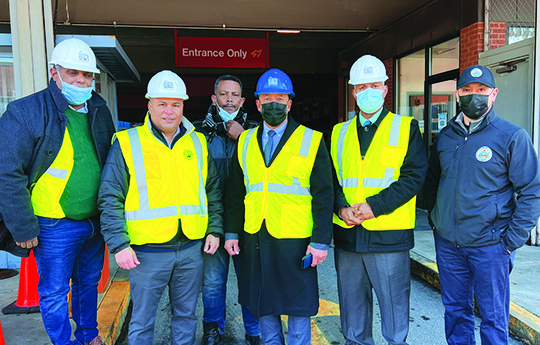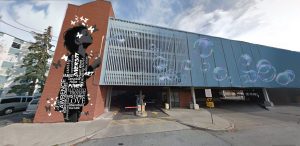
Buckley Transportation Center renovations
By Dalia Díaz
As a matter of precaution, the City of Lawrence inspected the conditions of the Buckley Garage on the corner of Amesbury and Common St., to avoid the situation that presented itself at Museum Square.
The information that follows was taken from a report issued to the City of Lawrence compiling the observations of the team although nothing was ever done.
This was brought to the attention of Mayor Brian De Peña by DPW Director Jorge Jaime who discovered that the stairs were in such a poor state that needed to be replaced. Upon further inspection, several other repairs were deemed necessary to keep it in optimal conditions.
The building’s interior has been well maintained and is in good condition. The main areas of deficiency on the interior are due to water damage, normal wear, and code requirements. Water penetration on the lower floors of the stairs in both towers has caused erosion to the metal structure and spalling of the concrete landings and treads. The fourth-floor elevator enclosure has water stains on the ceiling from a leak in the roof.
Accessibility entering and exiting the covered portion of the garage forces users to go back and forth between the sidewalk and asphalt roadway. Multiple blind spots for drivers and bus traffic along with the walking paths in their current state should be considered a pedestrian safety shortfall. Also, vehicular traffic entering the parking garage partially blocks pedestrian traffic due to the entrance gate location.
The existing garage has four major elements from a traffic circulation point of view. The first element is vehicular access to the garage. The second element is vehicular circulation within the garage. The third element is pedestrian and bicycle circulation around and within the garage. The fourth element is the circulation of Merrimack Valley Transit Authority (MVTA) busses within the first-floor bus depot and intermodal terminal.
Pedestrian circulation within the garage is adequate. No attempt has been made to determine compliance with Americans with Disabilities Act (ADA) or Architectural Access Board (MB) standards. However, there appears to be adequate pedestrian circulation within the garage itself.
The sidewalks along Common Street and Amesbury Street are inadequate for appropriate pedestrian circulation. Numerous obstructions make pedestrian pathways substandard in terms of width relative to ADA/AAB standards. In addition, ever where the path of travel is technically sufficient, pedestrian level-of-service is inadequate owing to the numerous obstructions. On Common Street, there is a primary switchgear station that significantly obstructs pedestrian travel, as well as numerous poles, and trees.
Existing electrical service to the building is provided by a pad-mounted transformer on Common Street. The service main is 225amp, 480v three-phase, and metered as a single service. The service appears to be sufficient for the existing loads in the building. Six car charges are located in the lower level. These devices appear to be a recent addition to the building systems. No vehicles were being charged during the visit.
With the garage being renovated, this presents the city with the opportunity to eliminate the booths or replace them with state-of-the-art parking systems. The city is systematically upgrading all city-owned parking facilities. As part of that process, the city is upgrading all of its revenue collection systems. It would be logical to standardize revenue collection systems across the city by using the booth and revenue collection system currently being installed at the Common Street parking lot.
The other approach to revenue collection would be to use a radio frequency identification (RFID) system, either exclusively or just for permit parkers. For instance, permit parkers could be issued an RFID tag that activates the gates and allows for an expeditious exit from the facility. This would reduce the potential for queues to develop and improve the overall customer experience. For this reason, we recommend the inclusion of RFID technology for permit parking.
Regardless of the method of revenue collection, the booths should be moved further into the garage to allow for adequate queueing without blocking the sidewalk or disrupting traffic in the travel lanes of the two adjacent streets. We recommend a sufficient queuing area for 3 vehicles within the garage. To provide queueing for three vehicles, the booths would need to be placed 60 feet from the back of the sidewalk at the entrances.
Merrimack Valley Regional Transit Authority (MVRTA) Terminal
The first floor of the garage functions as the MVRTA bus terminal in downtown Lawrence. Known as the Buckley Transportation Center, this facility accommodates 16 service lines. Buses circulate every half-hour. All busses arrive at the Buckley Transportation Center at roughly the same time and depart at roughly the same time.
The bus circulation in the Buckley Transportation Center flows very efficiently. The arrivals and departures are a very well-choreographed event. However, egress from the terminal is challenged by traffic queues on Amesbury Street southbound at Common Street.
Vehicular access to the garage is provided at two access and egress points. One access point is on Amesbury Street and one access point is on Common Street. Each access point has substandard access and egress conditions.
The report details what changes will take place at both entrances and exits to facilitate automobiles in and out and bus traffic as well as vehicles traveling on Common St. and Amesbury St.
Bicycle parking is inadequate in the garage. There is bicycle parking within the bus terminal area of the garage on the westerly end. However, there is no bicycle parking at the easterly end of the garage. This prevents efficient loading of bicycles for those boarding busses on the east end of the terminal.
Mayor De Peña points to the stairs as the most immediate replacement to be done given their dilapidated state. Overall, these are easy fixes that will not cost lots of money in repairs and prevent major expenditures in the future.
DPW Director Jorge Jaime
Early in his administration, Mayor Brian De Peña appointed Jaime to this position, resulting in negative criticisms. Most of those opinions came from people who knew Dr. Jorge Jaime from the Dominican Republic. Having a medical background seemed impossible for this man to adapt to the harshest working conditions, but Jorge has shown an ability to place his responsibility over any desires or preconceived ideas.
When he arrived in Lawrence where most of his family and in-laws had relocated, the most important need was supporting his family. Mayor William Lantigua opened the doors of city hall and he began to prove himself.
A few years later, he was working for DPW and being familiar with the City’s needs, Jorge decided to run for mayor. Mayor Daniel Rivera was running for a second term and having Jorge working all over the city in contact with the general public, was seen as a political threat.
That’s when he appointed him to the cemetery where he would be isolated, away from the public. The campaign came to a halt but Jorge Jaime was the star of Bellevue Cemetery.
That background through the years earned him the appreciation of coworkers as well as supervisors and Brian tapped him to straighten things out in the city.
As soon as he had access to financial information the director of the Department of Public Works discovered that this garage is not profitable for the city. If it’s always full and they are not accepting cash, only credit cards with many monthly parkers, how come it’s not making any money?
The first indication that something was awry was the lack of a list of monthly parkers, permits granted to the Police Department, DPW workers or any other city employee.
Director Jaime canceled all parking permits renewing them upon entrance to the garage. “That way, we have a clean slate knowing how many monthly permits are given out and paying their dues,” he told me.
This is not the first time that department was not managed by a civil engineer and Brian told me upon asking, “What that department need is a ‘worker,’ someone who fixes what’s broken.”
Brian went on to praise the work he had done at Bellevue Cemetery. When Jorge Jaime was appointed on a temporary basis as its director, he went directly to the Board of Directors and told them that he had never done that type of work so he needed for them to be patient while he learned the job. That honesty earned their respect and soon they were asking the mayor to appoint him permanently.
The cemetery was not earning the revenues it should have and Jorge turned that around.
First, he tackled the cleanliness, the overgrown trees and bushes, and the road conditions.
Lawrencians who were going to other communities to buy lots soon were coming back to bury their loved ones at Bellevue and the revenues went from under $100,000 to well over $400,000 last year. He says that the cemetery has the potential of earning close to one million dollars each year.
That was Brian’s motivation to bring him closer in his administration. Many things require fixing and he goes directly to those issues. He found out that there’s no inventory anywhere in the city and beginning with his department, he’s creating lists of equipment and supplies that no one was responsible to account for and there will be better measures in place to control the expenditure of gas at the city yard.
Jorge Jaime takes pride in his work and that’s his most important quality.



Be the first to comment